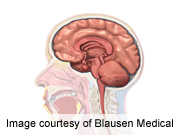- Skip Storing This Everyday Product in the Fridge Door
- Green Tea + B3 Pairing May Boost Brain Health
- Navigating Your Midlife Crisis: Embracing New Possibilities
- City Raccoons Showing Signs of Domestication
- Mapping the Exposome: Science Broadens Focus to Environmental Disease Triggers
- One Week Less on Social Media Linked to Better Mental Health
- Your Brain Changes in Stages as You Age, Study Finds
- Some Suicide Victims Show No Typical Warning Signs, Study Finds
- ByHeart Formula Faces Lawsuits After Babies Sickened With Botulism
- Switch to Vegan Diet Could Cut Your Greenhouse Gas Emissions in Half
Stutterers Show Different Brain Development, Study Says


FRIDAY, Oct. 18Children who stutter have less gray matter in regions of the brain responsible for speech than those who don’t stutter, a finding that could lead to improved treatments for the condition, according to a new Canadian study.
Researchers evaluated 28 children, aged 5 to 12, who underwent MRI brain scans. Half of the children had been diagnosed with stuttering, and the others acted as a control group.
The brain scans revealed that the children who stuttered had abnormal development of the inferior frontal gyrus region of the brain. It’s believed that this region takes information that the brain understands about language and sounds and codes it into speech movements.
“If you think about the characteristics of stuttering — repetitions of the first sounds or syllables in a word, prolongation of sounds in a word — it’s easy to hypothesize that it’s a speech-motor-control problem,” study author Deryk Beal, executive director of the Institute for Stuttering Treatment and Research at the University of Alberta, said in a university news release.
The study was published recently in the journal Cortex.
Previous research examined structural differences between the brains of adults who stutter and those who do not. The problem with that approach is the brain scans come years after the onset of stuttering, typically between the ages of 2 and 5 years, Beal said.
“You can never be quite sure whether the differences in brain structure or function you’re looking at were the result of a lifetime of coping with a speech disorder or whether those brain differences were there from the beginning,” Beal explained.
He said the results of his study are a first step toward testing to see how the amount of gray matter in the brain is influenced by treatment for stuttering and for understanding motor-sequence learning differences between children who stutter and those who don’t.
“The more we know about motor learning in these kids, the more we can adjust our treatment — deliver it in a shorter period of time, deliver it more effectively,” Beal said.
More information
The Nemours Foundation has more about stuttering.
Source: HealthDay
Copyright © 2025 HealthDay. All rights reserved.










